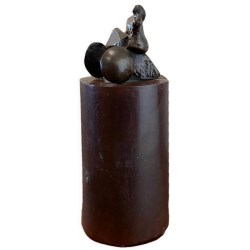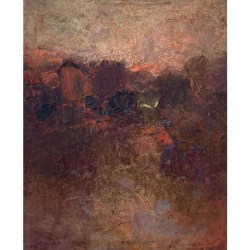International Masters: Víctor Vasarely
Lapidaire-2
Atelier Duo d’ Art, Genève
Editions Du Griffon
Neufchatel, Sweden
Serigraph on board
27.5″x6.25″x.25″ (columna acrilica)
4″x4″ each serigraph (8)
Signed and numbered
Editions 150
Mentioned Vasarely III. Ed.du Griffon pag 241
Exhibited at Ascaso Gallery 2011 (Vasarely, Agam, Schoffer)
Víctor Vasarely
(Hungarian 1908-1997) Hungarian-born Victor Vasarely is known as a founder of optical art. Vasarely was born in Pecs and grew up in Piešťany (then Pöstyén) and Budapest where in 1925 he took up medical studies at Budapest University. In 1927 he abandoned medicine to learn traditional academic painting at the private Podolini-Volkmann Academy. In 1928/1929, he enrolled at Sándor Bortnyik's Műhely (lit. "workshop", in existence until 1938), then widely recognized as the center of Bauhaus studies in Budapest. Cash-strapped, the műhely could not offer the whole range of its illustrious Bauhaus model, and concentrated on applied graphic art and typographic design.
Vasarely’s excellence in drawing was quickly noticed. In 1929 he painted his Blue Study and Green Study. In 1930 he married his fellow student Claire Spinner (1908-1990). Together they had two sons, Andre and Jean-Pierre. In Budapest, he worked for a ball-bearings company in accounting and designing advertising posters. Victor Vasarely became a graphics designer and a poster artist during the 1930’s who combined patterns and organic images with each other.
He studied at the Bauhaus Muhely in Budapest and in 1930 emigrated to Paris where he developed his particular vision which stems from the idea of democratizing the art object. Influenced greatly by the problems of the world's cities, he feels his work offers a solution by presenting a clear view of the "color-surface-perception" relationship.
Vasarely left Hungary and settled in Paris in 1930 working as a graphic artist and as a creative consultant at the advertising agencies Havas, Draeger and Devambez (1930-1935). His interactions with other artists during this time were limited. He played with the idea of opening up an institution modeled after Sándor Bortnyik Műhely’s and developed some teaching material for it. Having lived mostly in cheap hotels, he settled in 1942/1944 in Saint-Céré in the Lot département. After the Second World War, he opened an atelier in Arcueil, a suburb some 10 kilometers from the center of Paris (in the Val-de-Marne département of the Île-de-France). In 1961 he finally settled in Annet-sur-Marne (in the Seine-et-Marne département).
Over the next three decades, Vasarely developed his style of geometric abstract art, working in various materials but using a minimal number of forms and colours:
He has used the income from the sale of these "investigations," as he calls his prints, to establish a socio-cultural foundation in Aix-en-Provence, France, for the study of the integration of plastic beauty at all levels of the urban environment. He is represented in major museums all over the world and has received many artistic and honorary awards. Among these distinctions are the French Legion of Honor, the Guggenheim Prize, and the Gold Medal of the Triennale in Milan.
On 5 June 1970, Vasarely opened his first dedicated museum with over 500 works in a renaissance palace in Gordes (closed in 1996). A second major undertaking was the Fondation Vasarely in Aix-en-Provence, a museum housed in a distinct structure specially designed by Vasarely. It was inaugurated in 1976 by French president Georges Pompidou. Sadly the museum is now in a state of disrepair, several of the pieces on display have been damaged by water leaking from the ceiling. Also, in 1976 his large kinematic object Georges Pompidou was installed in the Centre Pompidou in Paris and the Vasarely Museum located at his birth place in Pécs, Hungary, was established with a large donation of works by Vasarely. In 1982 154 specially created serigraphs were taken into space by the cosmonaut Jean-Loup Chrétien on board the French-Soviet spacecraft Salyut 7 and later sold for the benefit of UNESCO. In 1987, the second Hungarian Vasarely museum was established in Zichy Palace in Budapest with more than 400 works.
He died in Paris on 15 March 1997
Available Artworks
Can’t find what you’re looking for?
We have access to a wide range of art collections to meet your requirements, ranging from Venezuelan & Latin American to international masters.
Contact us at +1 305 907-9960 regarding the artist you’re looking for; we’ll search and find it for you.
Starting your art collection
When starting a collection one must consider a variety of factors. First however, one must start by asking – why and how will I start to collect art?










